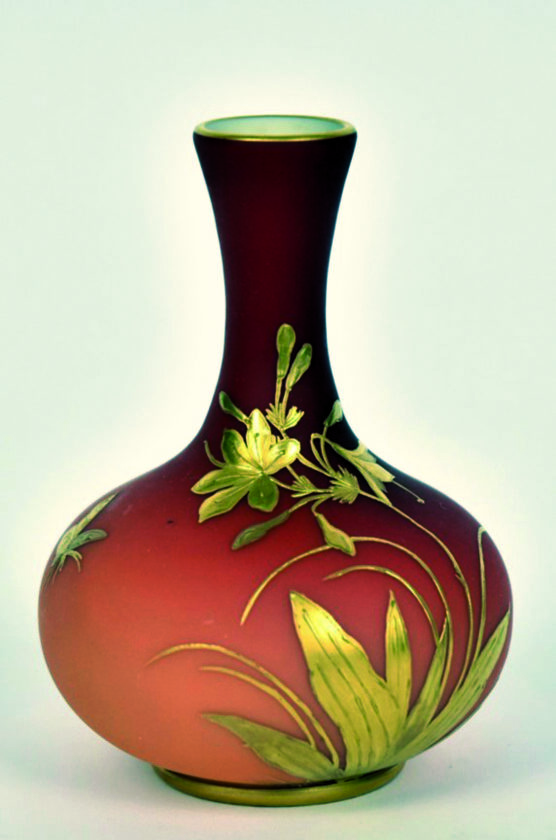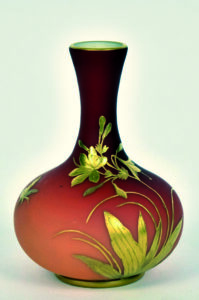Peach-tone glass antiques come in a variety of styles, techniques

For art glass collectors, a peachblow vase can be as much of a treat as a perfectly ripe peach at the peak of its season. Peachblow is one of the many types of two-tone art glass popular in the late Victorian era. The shaded glass craze began with Amberina, shading from amber to ruby, patented in 1883. Burmese glass, shading from pink to yellow, was registered in 1885.
In 1886, tonal pink shades came into vogue, thanks to the sale of a famous antique Chinese ceramic vase, today called the Morgan vase, with a mottled pink glaze described as “peachblow” or “peach bloom.” By then, many manufacturers had already perfected suitable opaque two-tone pink glass, so they capitalized on the vase’s fame with names like “Peachblow” (or “Peach Blow”), “Peach Bloom” and “Peach Skin.” The exact colors and glassmaking techniques varied among companies; for example, the Peachblow glass by Hobbs, Brockunier & Company had an outer layer shaded from red to amber and a creamy opaque lining, while Mt. Washington Glass Company used the name for a single-layer glass shaded from pink to pale blue.
The vase pictured here, made by the English company Thomas Webb & Sons, is shaded from red to peach. It sold for $163 at Forsythe’s Auctions. Like many pieces of peachblow glass, it has a satin finish; a velvety texture, perhaps reminiscent of a real peach’s skin, created with an acid vapor treatment.
——
Q: I have a chair that I found in an antique store. There is a maker’s mark on the bottom from the Heyman Company from Grand Rapids, Michigan. I can’t find any other chairs from them online, so it appears to be rare. I know it was made in the late 1880s, because that is when they were in business. The seat has fabric upholstery that looks original. There is no damage to it and there don’t seem to be any repairs done. It is in great condition. Can you give me a value on this?
A: Grand Rapids was an important center for furniture manufacturing from the late 19th to the mid-20th century. Companies mass-produced furniture in the popular styles of the time, like Renaissance Revival in the late 1800s and Arts and Crafts in the early 1900s. Because the furniture was made by machine, pieces were simpler than the elaborately carved styles of the earlier Victorian years. They had rectangular lines and flat surfaces. Oak and walnut were popular woods.
Grand Rapids manufacturers made furniture for all price points, but today, these pieces are usually inexpensive, unless they are by a famous maker like Stickley or Limbert. The Heyman Company is not as well known; we have found out little about the company other than that it was active until at least the 1940s. Grand Rapids chairs by unknown makers usually sell for about $50 or less. A maker’s mark or label increases the value of furniture. Your chair would be worth more, probably about $75 to $100.
——
Q: My father taught Engineering Graphics at Ohio State University during the 1960s and 1970s. One of his favorite students was from India and gifted him a carved ivory chess set sometime in the late 1960s. I know ivory is controversial, but there is a “cut off” date under which it could be imported. I have two questions: 1. Does the late 1960s fall within that date? 2. Is there a way to get an appraisal value?
A: International trade in elephant ivory was banned by the Convention on International Trade in Endangered Species (CITES) in 1989. It is legal to own ivory that was imported before then. Ivory chess sets like yours have been made in India for hundreds of years. We have seen sets from the mid-20th century valued at about $200. Sets from the 19th century can be worth more than a thousand dollars.
To get a more precise appraisal, you may want to look for an antiques dealer in your area or contact an auction house that handles ivory. Look for specialists in Asian art. If you are planning to sell your chess set, transport it across state lines or even give it as a gift, donation, or inheritance, be sure to check both federal and state laws. Federal laws regarding ivory have been updated several times in the last decade. The U.S. Fish & Wildlife Service (fws.gov) will have the latest federal laws.

